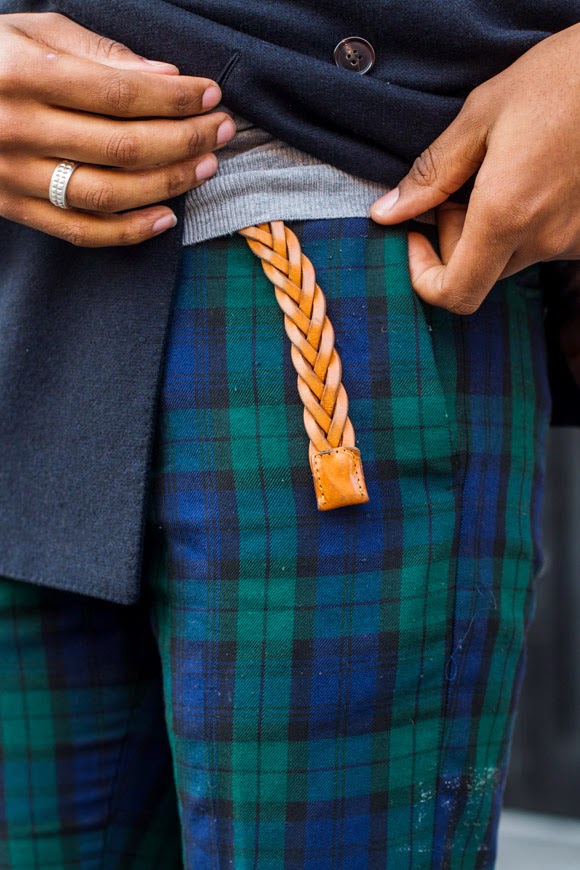From a pattern-making and tailoring perspective, the lapels are created by sewing together two layers of the jacket’s front panel and connecting them to the collar piece which wraps around the neck. On a well-made jacket there is often a piece of canvas gently hand-sewn between the two panels, which gives the jacket additional structure and dimension. Some historians of dress such as Bernard Rudofsky have ridiculed the evolution of jacket lapels into “vastly unnecessary flaps” and “decorative rudiments”, while others have celebrated the transformation of lapels into “fetishes” as part and parcel of fashion as expression.
Lapels typically have a buttonhole on the left, which is intended to hold a boutonnière, a decorative flower. These are now only commonly seen at more formal events. To hold the flower properly, a loop is fixed to the back of the lapel. For symmetry, double-breasted suits often have a button hole on each lapel.
Today there are three basic lapel shapes, although they come in a variety of widths and each designer has their own subtle take in terms of angles and lines. The lapel style is perhaps the most important (and eye-catching) element of a jacket and ultimately determines what it should be used for, along with the fabric, fit, button closure, etc.
Here’s a quick breakdown of your options.
THE NOTCH LAPEL
The “notch” is the “sideways V” shape (<) between the top of the bottom of the collar and the top of the lapel. This is easily the most common lapel type (it’s much simpler and cheaper to cut than a peak) and has long been the standard on single-breasted suit jackets and sport coats. Old school jackets (think 80’s Armani) had wide notches and low gorge lines (the sewing line that connects the lapel to the collar). As trends have swung and lapels have narrowed we’ve also seen much smaller notches, sometimes called “fishmouth”.
If you’re only going to own one suit, make it a notch lapel in a medium width (roughly 3-3.5”). It’s the most timeless and versatile style you can buy and appropriate for everything from job interviews and your first day at work to weddings and high-end restaurants. If you’re choosing a lapel style on a custom piece, consider the fabric and style of the jacket. If it’s an unstructured jacket in a fabric that leans casual (like cotton or linen) it’s probably best suited for a notch.
THE PEAK LAPEL
So called because of the pointed tips, the peak lapel can be traced back to the frock coats of Louis XIV’s reign in the sixteenth century. Historians believe they came about simply out of a necessity to keep the neck warm and dry in inclement weather (by popping them up for coverage). Due to their historical association with morning coats and tailcoats, the peak lapel is by nature a more formal style. For this reason, they have become the standard on double-breasted jackets and tuxedos. Throughout the 1920s and 1930s, however, the peak lapel found its way onto many single-breasted suits and dinner jackets.
The peak lapel should be reserved for more formal, structured jackets in sharp fabrics like worsted wools and mohairs. They can give the appearance of broader shoulders and increased height – making them perfect for the power businessman, the shorter gent, and those carrying a few extra pounds who desire a lengthening effect. Ideally the lapel should be in proportion to the width of the wearer, covering roughly half the distance from the roll line to the shoulder seam. As we’ve mentioned, flattering the body with proper tailoring is all about proportions.
THE SHAWL COLLAR
The shawl collar, which is one continuous piece all the way around the neck, is becoming more and more popular with tailored gents looking for a suave cut. This is probably due to its promiscuous past, given that it was the lapel of choice for gentlemen’s clubs where the smoking jacket was the required uniform. It’s a swanky and decadent look, best reserved for evening wear and dinner jackets with only one button (although some designers have begun using them with more traditional suiting fabrics).
Although it’s one smooth piece of cloth, there are still plenty of considerations in terms of size and shape. The jacket pictured above, for example, has a squared-off bottom and actually gets slightly wider toward the bottom, as opposed to the traditional shawl which gets narrowest at the button. Lastly, in my opinion, a shawl collar should be reserved for bowties, not straight ties.
















